The hustle and bustle of modern life can quickly become tedious, so much so that it sometimes spills over into our homes. As such, creating and maintaining a harmonious home has never been more appealing.
Want to make your living space more peaceful? There is no better way to start than incorporating Japanese-inspired interior design into your home. This style embodies the values people often associate with Japanese culture—balance, simplicity, and serenity—creating a tranquil space to relax and take a break from the daily grind.
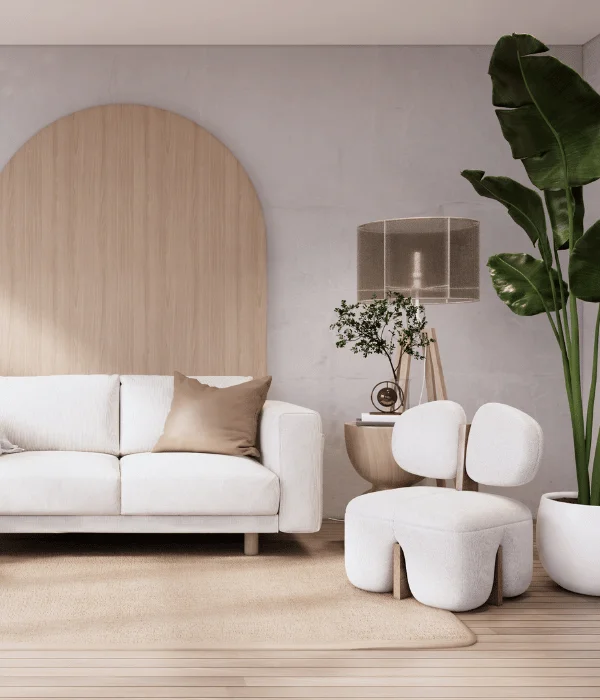
What is Japanese-Inspired Interior Design?
Japanese-inspired interior design fuses traditional Japanese aesthetics and contemporary design sensibilities. It draws from centuries-old principles while adapting to modern needs and preferences, encapsulating the essence of Japan’s rich cultural heritage. Essentially, it revolves around creating spaces that foster harmony and tranquillity.
In effect, Japanese-inspired interiors offer a way to escape the chaos of modern life and find peace in the simplicity of a well-designed space. Some key elements defining this style include:
- Minimalism: Japanese-inspired spaces are uncluttered and free from excessive ornaments. This minimalist approach promotes visual peacefulness and emphasizes the importance of functionality and practicality over unnecessary elements.
- Natural elements: Nature is a crucial aspect of Japanese culture and design. Integrating natural materials like wood, stone, bamboo, and paper into interiors connects you with the Earth, creating a more organic atmosphere.
- Neutral color palettes: Neutral and earthy hues dominate Japanese-inspired interiors. Tones like whites, beiges, soft grays, and muted greens create a calm, soothing environment while enhancing its connection to nature.
- Furniture and décor: Furniture pieces are typically low to the ground and have clean, simple lines, such as tatami mats, low dining tables, and floor cushions. Meanwhile, decorative items are limited to a few carefully chosen handcrafted pieces.
- Zen influence: Zen Buddhism greatly influences Japanese design, emphasizing the importance of mindfulness and meditation. Zen gardens, with their carefully raked gravel and stones, are iconic representations of this influence.
- Wabi-sabi: The concept of wabi-sabi celebrates transience and aging. It encourages using aged materials, embracing the idea that imperfections can enhance an object or space’s aesthetic and functional appeal.
7 Ways to Incorporate Japanese-Inspired Interior Design Into Your Home
A Japanese-inspired interior design can resolve any cluttered and stressful living space. Bring this aesthetic into your home by following these key elements and principles.
- Incorporate wabi-sabi elements
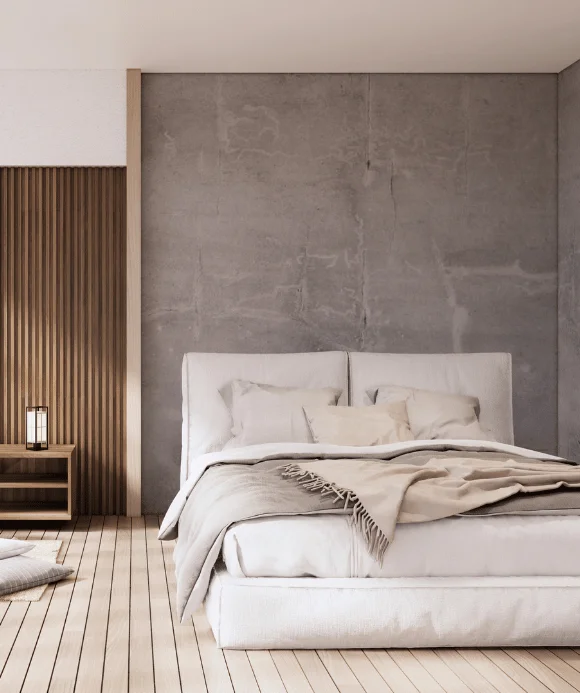
As mentioned, wabi-sabi is a fundamental concept in Japanese design that celebrates aging’s beauty and imperfections. A straightforward way to add this concept to your home is by opting for weathered furniture made from aged or reclaimed wood. Cracked pottery and slightly worn textiles are also wabi-sabi elements that make your home look rustic yet functional.
At the same time, do not shy away from artisanal pieces. These décor also exhibit the subtle irregularities that embody wabi-sabi and make them unique. So, consider displaying handcrafted pottery, upholstery, and artwork around your living area.
- Practice minimalism
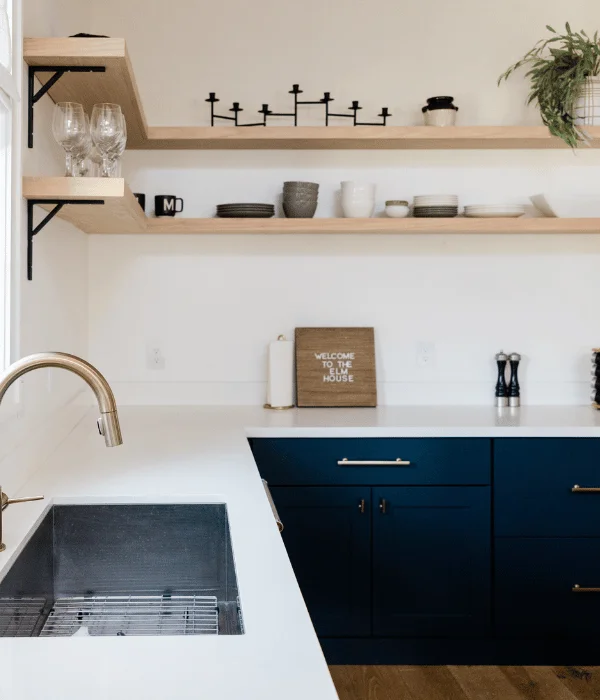
While wabi-sabi elements add personality to your home, it is also essential to practice minimalism. It is a core aspect of Japanese-inspired interior design that promotes a neat space free from potential distractions and messes.
Create a minimalist interior by decluttering—remove unnecessary items and focus on keeping surfaces clean and mostly empty. Choose clean lines and simple designs when shopping for furniture, minimizing unnecessary ornamentations. Low-profile furniture, like futons and platform beds, helps create an uncluttered look. Finally, limit your décor to meaningful pieces instead of overloading the space.
- Introduce natural elements
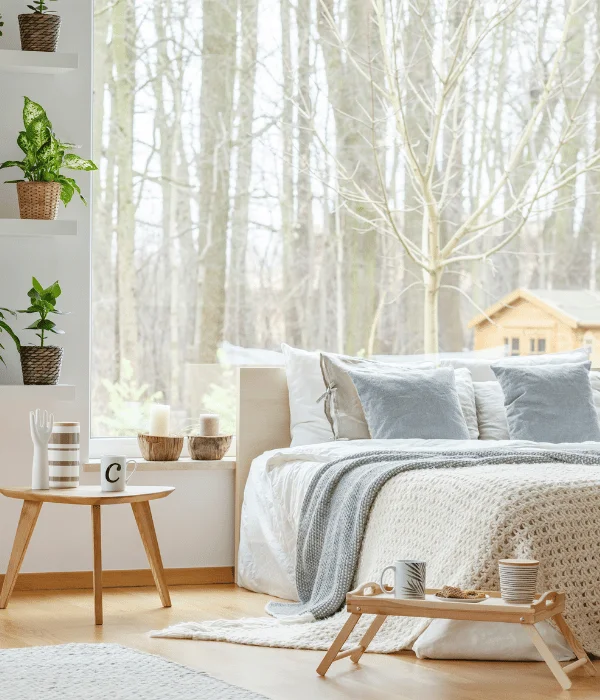
Nature is at the heart of most Japanese designs, so bring natural elements into your home. You can incorporate wooden flooring, furniture, and accents indoors to give your home a natural ambiance. Light and medium-toned woods are common choices, as dark ones make spaces look and feel smaller. Meanwhile, use stone for countertops or flooring and bamboo for windows or decorative elements.
Of course, plants and greeneries are also essential to a nature-centered home. Bring the outdoors inside with potted plants like bonsai trees, small bamboo, and other flora to add greens to your wooden interior. Some Japanese houseplants you can use include:
- Blue Jacaranda bonsai
- Azaleas
- Lucky bamboo
- Japanese Aucuba
- Hydrangea
- Ensure balance and feng shui
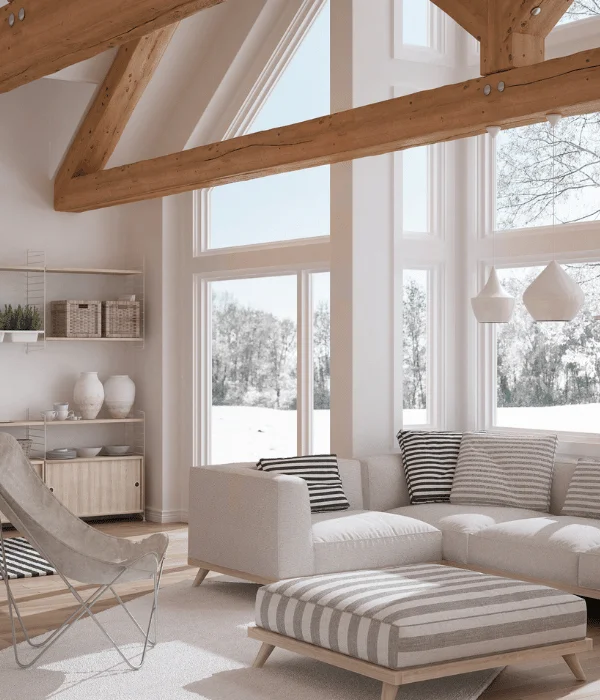
Balance and harmony are crucial concepts in Japanese design. A traditional way to observe these practices is by implementing feng shui when arranging furniture and décor to ensure optimal energy flow. For example, avoid blocking windows and doorways with furniture, and maintain an open area that will not disrupt movement.
It is also essential to balance your home through symmetrical arrangements like matching furniture or decorative items to reduce chaos within living spaces, enabling you to relax visually. Finally, maximize natural light using airy window treatments like sheer curtains and shoji screens. These implementations not only brighten up your home but also elevate its natural atmosphere.
- Add Zen meditation spaces
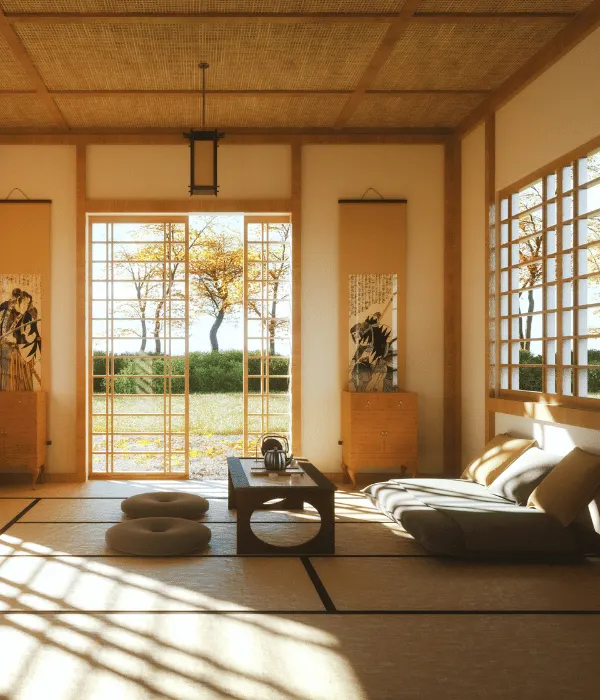
Zen meditation spaces allow you to sit down, relax, and meditate to improve your internal well-being. As such, it can be a profound addition to your Japanese-inspired interior. Luckily, you do not need to invest much to create such an area in your home.
Dedicate a quiet corner or nook for meditation and reflection; you can place a cushion or low chair for comfortable seating. Then, keep it minimal with a few select pieces—such as a bonsai tree, a small rock garden, or a wall scroll with a meaningful saying. Complete the space by burning incense and playing sounds from nature, like flowing water or birdsong.
- Integrate Japanese-inspired furniture and decor
Embrace Japanese-inspired interior design by incorporating authentic or inspired furniture and décor within your home. Tatami mats are some of the most essential elements you may add, especially in meditation spaces. You can also add a kotatsu table for a cozy and traditional Japanese vibe.
For furniture, start with platform beds for a minimal feel. Whichever you choose, opt for those made from natural materials like wood and bamboo. Lastly, consider decorating walls with Japanese artworks and calligraphy to showcase some of the country’s unique artistry.
- Be culturally sensitive
Finally, it is essential to approach Japanese-inspired interior design sensitively, especially if you are not Japanese. Understand the cultural significance of the elements you incorporate and use them respectfully. An excellent way to avoid cultural appropriation is by researching Japanese customs, symbolism, and traditions.
While drawing inspiration from Japanese design is terrific, avoiding overly themed or stereotypical interiors is better. If unsure, consider consulting with an interior designer specializing in Japanese design or someone with knowledge of the country’s traditional culture.
Live Harmoniously with a Japanese-Inspired Home
In a world where the constant rush of modern life quickly overwhelms us, the allure of Japanese-inspired interior design reminds us to seek balance and tranquillity in our homes. This style, rooted in centuries-old tradition, sustains its timelines and universal appeal among homeowners seeking stillness within their living areas.
Ultimately, introducing Japanese-inspired elements into your house lets you craft beautiful living spaces and nurtures your and your occupants’ well-being. By embracing the principles we have discussed, you can begin enjoying the serenity of your peaceful bubble.



